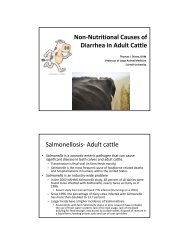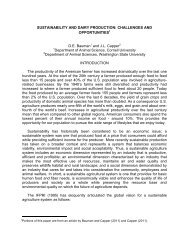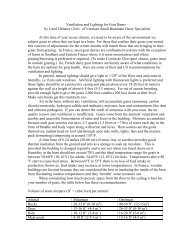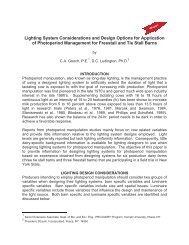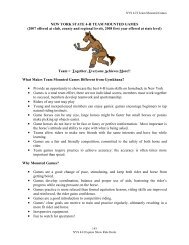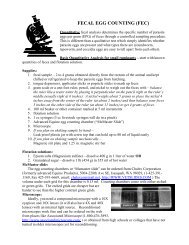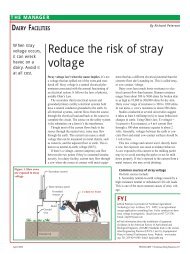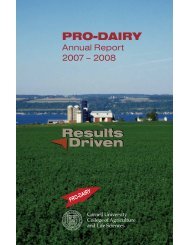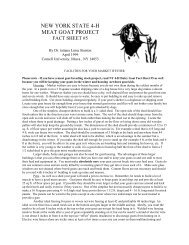2009 Proceedings of the Cornell Nutrition Conference For Feed ...
2009 Proceedings of the Cornell Nutrition Conference For Feed ...
2009 Proceedings of the Cornell Nutrition Conference For Feed ...
Create successful ePaper yourself
Turn your PDF publications into a flip-book with our unique Google optimized e-Paper software.
Estimating Thermal Damage in <strong>Feed</strong>s: The Furosine Procedure<br />
Furosine analysis has been used for over 40 years as an indicator <strong>of</strong> <strong>the</strong>rmal<br />
damage in foods (Erbersdobler and Somoza, 2007). ε-N-deoxyfructosyl-L-lysine is <strong>the</strong><br />
major Amadori compound formed during <strong>the</strong> early Maillard reaction (Figure 2). Upon<br />
acid hydrolysis, ε-N-deoxyfructosyl-L-lysine is released in a constant ratio <strong>of</strong> 50% lysine,<br />
30% furosine, 20% pyridosine, and 10% o<strong>the</strong>r compounds (Mauron, 1990). Therefore,<br />
<strong>the</strong> amount <strong>of</strong> furosine measured after acid hydrolysis can be used to calculate %<br />
blocked lysine according to <strong>the</strong> following equation (Mauron, 1990):<br />
% blocked lysine = (3.1 furosine x 100)<br />
[total lysine + (1.86*furosine)]<br />
The acid hydrolysis procedure used in furosine analysis is identical to that used in AA<br />
analysis <strong>of</strong> feeds. Therefore, <strong>the</strong> furosine assay is attractive because furosine and AA<br />
content <strong>of</strong> feeds can all be determined with one procedure. Pahm et al. (2008) used <strong>the</strong><br />
furosine procedure to estimate blocked Lys content <strong>of</strong> 33 DDGS samples, and <strong>the</strong><br />
average blocked Lys content <strong>of</strong> <strong>the</strong> samples was 16% with a coefficient <strong>of</strong> variation <strong>of</strong><br />
7%. Pahm et al. (2008) also reported that blocked Lys was correlated with standardized<br />
ileal Lys digestibility in swine (R 2 = 0.66). Boucher et al. (<strong>2009</strong>b) determined <strong>the</strong><br />
furosine content <strong>of</strong> 16 rumen undegraded residue (RUR) samples: 3 samples <strong>of</strong><br />
soybean meal (SBM), 3 samples <strong>of</strong> expeller SBM (SoyPlus ® ), 5 samples <strong>of</strong> DDGS, and<br />
5 samples <strong>of</strong> fish meal (FM). One <strong>of</strong> <strong>the</strong> SBM, SoyPlus, and DDGS samples were<br />
heated additionally in <strong>the</strong> laboratory oven to intentionally depress digestibility <strong>of</strong> RUP-<br />
Lys. Of <strong>the</strong> 16 samples analyzed, only 9 samples contained furosine, and only <strong>the</strong> 4<br />
unheated DDGS samples contained appreciable amounts <strong>of</strong> furosine (Table 1). Blocked<br />
RUP-Lys was calculated from <strong>the</strong> furosine and Lys concentrations <strong>of</strong> <strong>the</strong> RUR<br />
according to <strong>the</strong> above equation. The same 16 RUR samples were previously fed to<br />
cecectomized roosters to determine digestibility <strong>of</strong> RUP-Lys in vivo. Results <strong>of</strong> <strong>the</strong><br />
experiment indicated that blocked RUP-Lys determined via <strong>the</strong> furosine method was<br />
negatively correlated with standardized RUP-Lys digestibility (R 2 = 0.94; Y = 88.43–<br />
0.89X; P < 0.001, n = 9).<br />
Estimating Thermal Damage in <strong>Feed</strong>s: The Homoarginine Procedure<br />
Homoarginine is an amino acid that is not found in nature. Homoarginine is formed<br />
by <strong>the</strong> reaction <strong>of</strong> <strong>the</strong> epsilon-amino group <strong>of</strong> Lys (<strong>the</strong> NH3 group on <strong>the</strong> side chain) with<br />
O-methylisourea. If <strong>the</strong> epsilon-amino group <strong>of</strong> Lys is bound to ano<strong>the</strong>r compound, such<br />
as a reducing sugar, <strong>the</strong>n homoarginine does not form. Determining <strong>the</strong> amount <strong>of</strong><br />
homoarginine and Lys after <strong>the</strong> reaction with O-methylisourea allows for <strong>the</strong><br />
determination <strong>of</strong> <strong>the</strong> reactive Lys content <strong>of</strong> a feed, or <strong>the</strong> amount <strong>of</strong> Lys in which <strong>the</strong><br />
epsilon-amino group is not bound to ano<strong>the</strong>r compound.<br />
19



